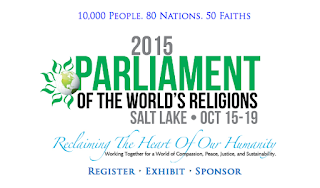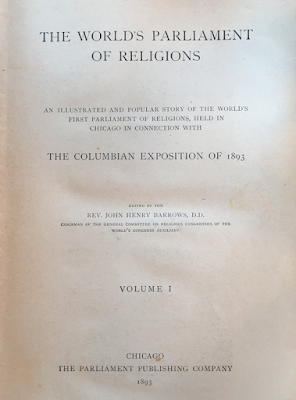The 1993 Parliament of the World’s Religions
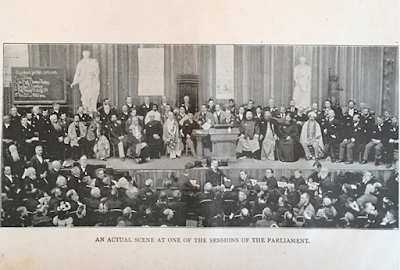 |
| Opening photograph found in a vintage copy of The World’s Parliament of Religions (Chicago: The Parliament Publishing Co., 1893). Photo also at https://en.wikipedia.org/wiki/Parliament_of_the_World%27s_Religions and http://www.parliamentofreligions.org/parliament/chicago-1893 |
On Tuesday, October 20 we published a report HERE by Lanette Irwin who attended the 2015 Parliament of the World’s Religions that was held Oct. 15-19 in Salt Lake City. Recently, while digging through some old writings, I discovered an article I had written just prior to the 1993 Parliament.[1] In my report I quoted from Volume 1 of The World’s Parliament of Religions (published in 1893 by The Parliament Publishing Company) which I had discovered in an antique store in Sedalia, Missouri. Some illustrations in today’s post are from this 1893 first Parliament book.
This vintage report on the 1993 Parliament is a snapshot in time. It is a brief summary describing the beginnings of what is referred to as the eco-ecumenical movement, the environmental causes hitching a ride on religious beliefs and groups. Below are excerpts. ~ Sarah H. Leslie
THE PARLIAMENTS, CIRCA 1893 & 1993
It is called the 1993 Parliament of the World’s Religions and it is scheduled for August 28-September 5 in Chicago, exactly one hundred years after the first Parliament of World Religions was held. The first great global conference, which was held in Chicago 100 years ago, embraced Charles Darwin, liberal theologies, and every new-fangled religious idea that arose out of the “enlightenment.”
The first Parliament was held in conjunction with the great World’s Columbian Exposition. Religious leaders at that time from all faiths across the earth were invited. According to the current conference brochure, that first Parliament “brought together some four hundred men and women representing forty one denominations and religious traditions. It lasted for seventeen days in September 1983…. It marks the beginning of interfaith dialogue in the modern world. Non-western religions also have recognized its importance. Several, such as Hinduism and Buddhism, trace their beginnings in the West to their participation” in this event. By all accounts, this conference was a monumental turning point for religion in the world.
“Hindu Swami Vivekananda attended the first Parliament. He espoused a pluralistic view of religious truth. ‘We accept all religions to be true.’”[2] This view is presumably going to dominate in 1993, since “liberal Christian thinkers and the Asian religions… will set the tone”[3] of the conference.
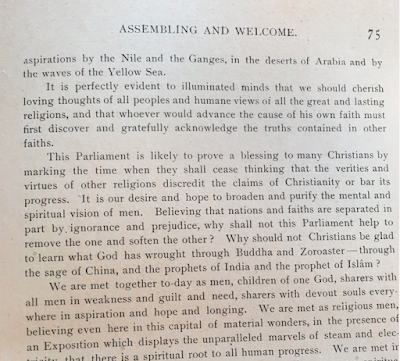 |
| An example of the agenda of the 1893 Parliament found in the book, p. 75. |
The 1993 Parliament will be convened for the purpose of promoting religious understanding and cooperation, diversity, and “challenges facing the global community,” according to the conference brochure. Further, it will “develop and encourage interfaith groups and programs which will carry the spirit of the Parliament into the twenty-first century.” The conference brochure clearly states the agenda: “The centenary of the World’s Parliament of Religions offers a unique opportunity for the community of religions to come together in a spirit of harmony and friendship…. We are committed to address issues of global significance as the world moves into the twenty-first century.” Also, the purpose of the Parliament is to “endeavor to integrate the spiritual life of individual, community, and world.”
As a prelude to the 1993 conference, a series of “Conferences on Critical Issues” were held. They covered topics of the “Earth (environmental protection, conservation of energy and resources, care of the earth and its creatures); The Human Community (relations between races, between women and men; the family); Economics and Justice (rich and poor nations and peoples; consumerism; the measures of development); Science and Technology, and Power, Politics and Liberation.”
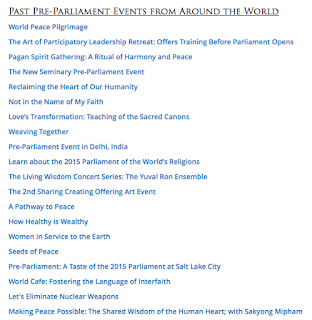 |
| The agendas continue. See the 2015 Pre-Parliament events HERE |
1993 CO-SPONSORS
The Council for a Parliament of the World’s Religions initiated the 1993 conference. There is an impressive list of co-sponsoring organizations (as of August, 1991) that make up a list of who’s who in New Age Spirituality. Since
one can assume that the mainstream media will be hyping this conference
as a spectacular show of global spiritual unity (orthodoxies not
welcome), we thought you would like to see the agendas of who’s who
groups who are co-sponsoring this event:
- American Buddhist Congress, Los Angeles
- American Islamic College, Chicago
- The Archdiocese of Chicago
- Spiritual Assembly of the Baha’is of Chicago
- First Baptist Church, Evanston, IL
- Brahma Kumaris World Spiritual Org., Mt. Abu, India
- Buddhist Council of the Midwest, Chicago
- Catholic Theological Union, Chicago
- Center for the Study of Vision, DePaul University, Chicago
- Chicago Center For Religion & Science at Lutheran School of Theology
- Chicago Disciples Union, Christian Church Oak Park, Chicago
- Theological Seminary Sri Chinmoy Center, Chicago
- Common Ground, Deerfield, IL
- Community Renewal Society, Chicago
- Conscious Choice Magazine, Chicago
- H.H. The Dalai Lama, India
- Evangelical Lutheran Church in America, Chicago Synod
- Gobind Sadan USA, New York
Guru - Gobind Singh Foundation, Rockville, MD
- Hindu Temple of Greater Chicago, Lemont, IL
- Institute for World Spirituality, Chicago
- Institute for Twenty-First Century Studies, Arlington, VA
- Interfaith Ministries, Wichita, KS
- International Council of Community Churches, Palos Hts, IL
- Federation of Jain Associations in North America, Cincinnati, OH
- Maha Bodhi Society of India, Calcutta, India
- McCormick Theological Seminary, Chicago
- Meadville-Lombard Theological School, Chicago
- United Methodist Church, Northern Illinois Conference, Chicago
- Muslim Community Center, Chicago
- North American Board for East-West Dialogue, St. Joe, MN
- The Organization for Universal Communal Harmony, Chicago
- Presbyterian Church USA, Louisville, KY
- Spertus College of Judaica, Chicago
- Spiritual Growth Network, Lexington, KY
- General Convention The Swedenborgian Church, Newton, MA
- Church of the New Jerusalem Swedenborgian, Bryn Anthyn, PA
- Swedenborg School of Religion, Newton, MA
- The Temple of Understanding, New York
- The Theosophical Society in America, Wheaton, IL
- The Theosophical Society, Pasadena, CA
- Unitarian Universalist Association
- United Church of Christ, Ecumenical Affairs, Chicago
- Metro Association Vivekananda Vedanta Society, Chicago
- Wat Dhammaram Thai Buddhist Temple, Chicago
- Women of Faith Resource Center, Chicago
- Federation of Zoroastrian Association of North American, Hinsdale, IL
CARING FOR CREATION
An “Inter-continental Conference on Caring for Creation” was held in Washington, D.C. in May 1990 as one of the prelude conferences leading up to the Parliament. According to this conference brochure, the religious leaders represented were to “discuss eco-ecumenical principles for planning and action throughout the ‘90s, including preparations for the UN conference on Development and the Environment in Brazil, and preparations for the “Earth” section of the Parliament of World Religions in the United States in 1993.” This links the agendas of the recent UN Rio conference and the World Parliament of Religions.
The “Caring for Creation” conference was sponsored by something called the North American Conference on Religion and Ecology (NACRE) and suggested presenting “local faith communities the first steps of an environmental ministry.” The conference was loaded with co-mingling the environmental movement’s agenda with a new “creation spirituality.” Significantly, Senator Al Gore was honored at the reception. Al Gore’s recent book Earth in the Balance, also espoused a new creation-based world religion based on James Lovelock’s “Gaia” hypothesis (i.e., that the Earth is a living entity and deity, see p. 264-265).[4]
The “Earth Covenant” was introduced at this conference. This covenant was “a major public initiative relating to the Earth Summit in Rio. It consists of a one-sentence ‘pledge’. The United Nations expects hundreds of millions of people in every part of the world will sign or offer their thumb print to the Covenant.” The pledge, to be circulated in many languages, reads as follows: “Recognizing that people’s actions toward nature and each other are the source of growing damage to the environment and resources needed to meet human needs and ensure survival and development, I pledge to act to the best of my ability to help make the Earth a secure and hospital home for present and future generations.”[5]
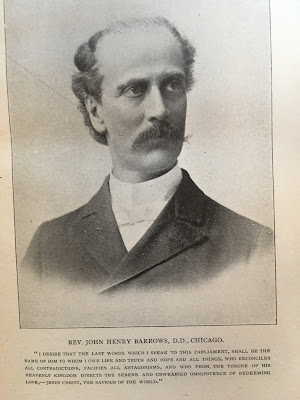 |
| Barrows’ photograph in the 1893 book. Read more: https://en.wikipedia.org/wiki/John_Henry_Barrows |
CANBERRA: A PRELUDE
The World Council of Churches held a 7th Assembly in Canberra, Australia, in February 1991. For all practical purposes, it appears that this was the prelude for the Chicago Parliament of Religions. According to one report: “Liberation theologies… re-read the Bible and re-interpret Christian tradition and theology from their experience of oppression and liberation. This must be the time we have to re-read the Bible from the perspective of birds, water, air, trees and mountains, the most wretched of the earth in our time. Learning to think like a mountain, changing our centre from human beings to all living beings, has become our ‘responsibility’ in order to survive.”[6]
The report also said that “Professor Chung, a Presbyterian educator, called for this theological development in her keynote address… ‘Come Holy Spirit, Renew the Whole Creation.’ Accompanied by a troupe of dancers with gongs, drums and banners, and Australian aborigines in paint and loincloths, she invoked ancestor spirits….”[7]
This new environmental spirituality was linked to global education: “A major report of the WCC Assembly, titled ‘Giver of Life, Sustain Your Creation,’ brought the WCC into the center of the environmental ideology now sweeping the ecumenical churches. The report lays out a ‘theology of creation,’ then elaborates an ‘ethic of economy and ecology’ and ends with specific demands for action… The ethical program envisions an ‘alternative model of society’ in which ‘people of different faiths… learn from each other’s spirituality’ to create ‘a world in which the needs of all creation are integrated…’ Beyond the reform of current institutions, the report calls for revamping ‘the International Economic Order’ and a reconception of economic thinking that is based on ‘sustainability.’ Most specifically, an ‘Earth Charter’ modeled on the Universal Declaration on Human Rights—known as the Universal Declaration of Human Obligations Towards Nature—is to be enacted.”
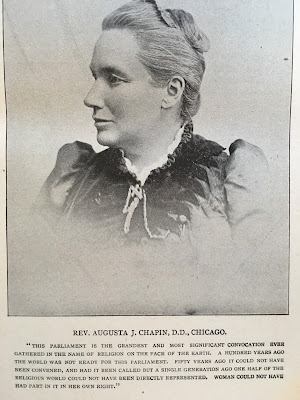 |
| Women have been very influential in promoting the Parliament. Here is an 1893 example. |
The report calls for the alteration of global education in order to proliferate a “sustainable spirituality” based on “global interdependence”: “Only the recognition on a worldwide scale of the oneness of creation can provide the critical global consciousness necessary to chart a new course for a sustainable future.”[8]
Australian believers issued a worldwide warning to Christians regarding this WCC Assembly titled “An Open Letter To All Christians.” They also noted the introduction of several variations of “earth covenants” at the Assembly related to “Stewardship,” “Justice, Peace and Integrity of Creation,” and “One World Declaration.”[9]
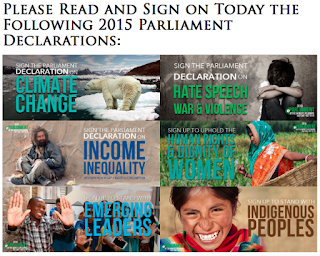 |
| 2015 Declarations HERE |
Re-defining “covenant” so that it no longer has traditional, orthodox Judeo-Christian meaning, then, becomes an interesting development in the current restructuring of America’s major denominations…. The United Church of Christ denomination (UCC) has been developing a new ecclesiology which features a new definition of “covenant” and a mission to “hear and give voice to creation’s cry for justice and peace.”[10]
It is highly likely that the 1993 Parliament of the World’s Religions will promote this new global spirituality which advocates a radical environmental agenda coupled with some form of stewardship “covenant.” The agenda calls for interfaith meditation, a keynote address by the Dalai Lama, and a Plenary which “calls to action on the Critical Issues, The Universal Declaration of Human Values”, and an “Invocation of Blessing on the 21st Century.”[11]
Endnotes:
1. Published in the FWR Report, July 1993, p. 3.
2. “East, West will meet in Chicago,” Larry Witham, Washington Times, 2/13/92.
3. Ibid.
4. To read more, see Berit Kjos’s website, including the following articles: http://www.crossroad.to/charts/new-story.htm and http://www.crossroad.to/Books/UnderSpell/1-Earth.htm and http://www.crossroad.to/text/responses/AlGore.htm and http://www.crossroad.to/text/articles/tstotw1196.html and http://www.crossroad.to/articles2/007/discernment/2-26-networking-4.htm
5. From In Our Hands, A reference booklet about the United Nations Conference on Environment and Development, June 1992.
6. Prof. Chung Kyung-Hyung, quoted in “What Spirit Comes When the WCC Calls?” by Lawrence E. Adams, Religion and Democracy, April 1991.
7. Ibid.
8. “‘Spirit’ not ‘Always Linked to ‘Truth’ at Recent WCC Assembly,” Lawrence Adams, Religion and Democracy.
9. See the current Declarations here: http://www.parliamentofreligions.org/parliament/salt-lake-2015/declarations
10. This agenda continues. See the following Herescope posts: https://herescope.net/2009/02/manifestos-declarations-and-covenants.html and https://herescope.net/2009/01/new-global-civility.html and https://herescope.net/2009/12/manhattan-declaration.html
11. To see how accurate this prediction was, see: http://www.irfwp.org/wp/index.php/parliament-follow-up-letter/

